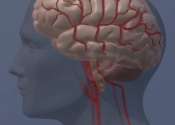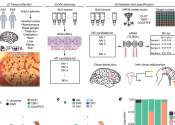With hybrid brains, these mice smell like a rat
If mice ever wonder what it's like to experience the world as a rat, some are now able to live that dream, at least when it comes to the sense of smell.
Apr 25, 2024
0
0
If mice ever wonder what it's like to experience the world as a rat, some are now able to live that dream, at least when it comes to the sense of smell.
Apr 25, 2024
0
0

An international research team, led by Tibor Harkany and Robert Schnell at Karolinska Institutet and MedUni Vienna's Center for Brain Research, set out to find ways of influencing hormone release to reduce stress reactions ...
Apr 23, 2024
0
26

Neuropeptides, which are broadly considered to modulate synaptic communication, can have unique and life-long effects on brain development, particularly the wiring of neuronal circuits.
Apr 23, 2024
0
57

Metachromatic leukodystrophy is a rare genetic disorder that mainly affects young children and results in severe neurological symptoms accompanied by a loss of motor and intellectual capacities. At Paris Brain Institute, ...
Apr 22, 2024
0
8

European researchers are pioneering a vaccine and treatment for amyotrophic lateral sclerosis.
Apr 19, 2024
0
12

A growing body of research shows that exposure to air pollution, especially during pregnancy and childhood, may have a negative impact on brain development. Now a study led by the Barcelona Institute for Global Health (ISGlobal) ...
Apr 17, 2024
0
0

A group of researchers at University of California San Diego School of Medicine led an investigation that offers new insight into the development of the human forebrain.
Apr 17, 2024
0
51

What determines mental health, school performance, and even cognitive development? A new study in Reviews in the Neurosciences suggests that poverty and low socioeconomic status (SES) are key contributory factors. Other studies ...
Apr 15, 2024
0
21

An international team of researchers has discovered what causes an unusual and incredibly rare genetic condition, giving hope to the families with it and others with related disorders.
Apr 15, 2024
0
16

Scientists at the Center for Developmental Neurobiology and MRC Center for Neurodevelopmental Disorders published a study titled "Somatostatin interneurons control the timing of developmental desynchronization in cortical ...
Apr 10, 2024
0
21

The study of neural development draws on both neuroscience and developmental biology to describe the cellular and molecular mechanisms by which complex nervous systems emerge during embryonic development and throughout life.
Some landmarks of embryonic neural development include the birth and differentiation of neurons from stem cell precursors, the migration of immature neurons from their birthplaces in the embryo to their final positions, outgrowth of axons from neurons and guidance of the motile growth cone through the embryo towards postsynaptic partners, the generation of synapses between these axons and their postsynaptic partners, and finally the lifelong changes in synapses which are thought to underlie learning and memory.
Typically, these neurodevelopmental processes can be broadly divided into two classes: activity-independent mechanisms and activity-dependent mechanisms. Activity-independent mechanisms are generally believed to occur as hardwired processes determined by genetic programs played out within individual neurons. These include differentiation, migration and axon guidance to their initial target areas. These processes are thought of as being independent of neural activity and sensory experience. Once axons reach their target areas, activity-dependent mechanisms come into play. Neural activity and sensory experience will mediate formation of new synapses, as well as synaptic plasticity, which will be responsible for refinement of the nascent neural circuits.
Developmental neuroscience uses a variety of animal models including mice Mus musculus , the fruit fly Drosophila melanogaster , the zebrafish Danio rerio, Xenopus laevis tadpoles and the worm Caenorhabditis elegans, among others.
This text uses material from Wikipedia, licensed under CC BY-SA